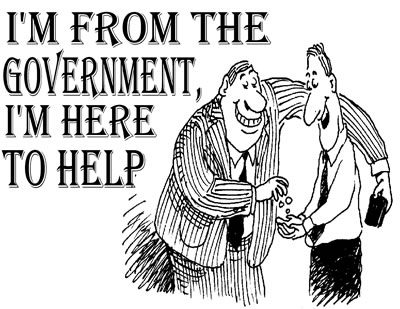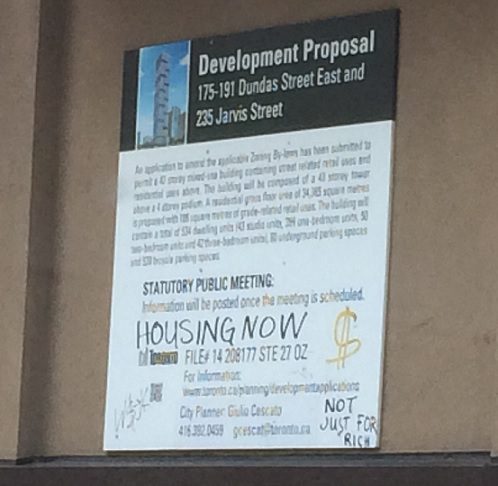Seriously, why not? It’s actually a pretty good idea.
After all, society seems to blame the government for just about every problem known to man, especially those for which society, via man, are responsible…
When times are tough, people shout, “Why won’t the government do something?”
In the case of high real estate prices, some people are starting to shout…

Let’s suggest, just for sake of argument, that instead of building two 90-storey condominiums at King & John Streets in downtown Toronto, the Mirvish-Gehry consortium decided instead to build three detached, 4-bed, 5-bath houses, on 35 x 150 foot lots.
Would those look a little out-of-place?
I think that question is rhetorical, however a good chunk of society seems to believe that there “should” be more family homes built, and that the government “should” provide more serviced land for housing.
A couple of weeks ago, a newspaper columnist called me for a comment on a study coming out of Ryerson University, which I found to be quite bizarre.
The study, if you can call it that, basically concluded that real estate prices are high because demand is greater than supply.
And it took them four months to come up with that?
The columnist asked me to comment, but I really didn’t know what to say. What was the question? What was the actual story here?
Here’s a story for you: “You need air to help you breathe, and breathing is a good way so stay alive.”
I’ve been interviewed hundreds of times, but this one really stumped me. I just had no clue what to say about this “study.”
So I read the study, and then I became more confused.
In essence, the study essentially “concluded” that the government is partly to blame for the high price in real estate.
You can read the whole study HERE.
The study went from point a, to point b, and found conclusion at point c.
Essentially that the government is not providing enough serviced land, and thus not enough homes are being built, and thus housing prices have risen.
Sure. That makes perfect sense.
But is it the government’s job to provide serviced land?
The study explains:
This serviced land shortage has happened even though the Province, through Policy 1.4.1 of its Provincial Policy Statement (PPS), requires that all planning authorities (municipalities):
“Maintain at all times where development is to occur, land with servicing capacity sufficient to provide at least a three-year supply of residential units available through lands suitably zoned to facilitate residential intensification and redevelopment, and land in draft approved and registered plans.”
I won’t lie to you – I’m not familiar with the Provincial Policy Statement.
But having read the above, was it ever reasonable to expect that the municipality would keep a three-year reserve of readily serviced land?
This isn’t a block of aged cheddar, sitting in a massive warehouse, with hundreds of other blocks.
How much is “three years’ supply” anyways? Is that supply based on anticipated demand?
If that’s the case, then in theory, the supply could be infinite, no?
So is it the responsibility of the Provincial government to keep an infinite supply of land available?
I know you think I’m being facetious, but I’m not. The reason why Toronto’s real estate market keeps chugging along is because buyers, both foreign and domestic, are dying to get their hands on anything real estate related, and have been for quite some time.
So if you had, in theory, a show of hands for how many people wanted “lands suitably zoned to facilitate residential intensification,” then wouldn’t everybody in the world raise both hands?
Perhaps when this policy was written, times were different.
Times change as years pass by, and so too does the world in which we live, but much of society seems not to notice.
I always use the example of the classic 1950’s American family, with the husband working at “the factory” from 9-5, Monday to Friday, coming home to two children gleefully laying on their stomachs in front of the TV, and a wife who wears a fancy dress all day, and has dinner waiting. They enjoy their two vacations per year, lead a nice middle-class lifestyle, and retire at 55-years-old.
That was in the 1950’s, and the American population has more than DOUBLED since then.
So it seems to reason that what was normal, and expected, back then, is no longer.
The world is far more competitive, and life in general just requires a hell of a lot more out of people than it used to.
So is old policy, that suggests we keep three years’ worth of readily serviced land, in any way realistic in Toronto in 2015?
How much land is “demanded” is up for debate, as noted above.
But where do you get the land to begin with?
Did you all read THIS article in Friday’s Globe & Mail? About Beatrice House being sold to condo-developer Urbancorp? The article also notes that Cornerstone Place men’s shelter has also been closed, and will soon be a condominium project.
So where then, do we get this land?
Should the city sell off assets in a fire-sale?
Turn schools and parks into vacant land, ready for a slew of townhouses?
How about the “Greenbelt?” Is it time to revisit the entire idea?
THIS recent article from the CBC seems to argue so.
And yet THIS recent article from the Toronto Star seems to argue not.
The Ryerson study discusses “ground-related housing” as though we’re in the middle of the desert, with nothing but vacant land in front of us, when in reality, every parking lot in the downtown core IS, like it or not, going to be high-rise living.
Again – would it be unusual to see three detached houses built instead of the two 90-storey towers at the Princess of Wales Theatre site? Try to disagree. Just try.
Then again, certain parts of society disagree, no matter what.
The Tim Horton’s at Dundas & Jarvis has this development proposal on the exterior wall:

What does the one person mean by “Housing Now?”
And what does the other person mean by “Not Just For Rich?”
I think it’s fair to say that “rich” people aren’t buying pre-construction, 1-bedroom condos at Dundas & Jarvis. Maybe we have a different interpretation of “rich,” and if an individual thinks that anybody who owns property is “rich,” then we have a major disconnect between the have’s and the have-not’s.
But whoever wrote “housing now,” seems to be in the camp that believes the government’s role is to provide, provide, provide.
Forget about the person or company who bought this land for millions of dollars, and has held it for year after year, with the intention of spending 5-7 years developing it, with millions of dollars at risk, in attempts to make a profit – you know, the way the free market, and capitalism, allow.
Instead, the artist with the black magic marker seems to think that the government (even though they didn’t own this) should build “housing, now.”
For who?
Presumably those who frequent the area……..if you know who frequents the area…
Sure, there’s a chance that another Ryerson PhD candidate, with black Sharpie in tow, wrote “Housing Now” to suggest that the developer of this condominium project should consider constructing low-income housing, and look for government grants to make up for the potential loss in profits.
But I suspect it was a squeegee-kid, or somebody else who while being on the short end of luck and circumstance in life, probably isn’t grinding out a 60-hour work-week to try to get ahead either.
Maybe that’s way too political, and way too much of a tangent. Or maybe it’s spot-on.
But I’ve seen numerous newspaper articles in the past month making reference to the government not providing enough land for new residential houses, and this is something entirely new. We weren’t hearing about this last year, or the year before. It seems to be the flavour of the week.
The National Post ran an article called “Gap Between Toronto Condos & Low-Rise Homes Jumps A Record $100,000 From Last Year” and had this to say:
“The effect of new-home pricing is also trickling down to resale homes, which is something that affects all homebuyers,” Tuckey added. “As inventory borders on record low levels, we need an adequate supply of low-rise homes to ensure healthy levels of housing choice that are necessary to accommodate the needs of our expanding region.”
Critics have suggested government policies aimed at intensification have created a shortage of detached homes and other low-rise housing, helping to drive prices to record levels across the GTA.
–
It’s happening in other markets as well. Take a look at the article below and the excerpt:
“Vancouver Residents Blame Foreign Buyers For Housing Prices”
“The B.C. Real Estate Association argued last week that the primary reason behind higher housing values is densification, notably the reduced supply of detached homes and the focus on building condos on a limited land base.”
Classic!
Somebody points the finger at speculative foreign buyers, and the B.C. Real Estate Association argues that land is limited, and condos are being built instead of houses.
So we have finger-pointing, blaming, and, well – a very logical argument.
Yes, land is limited.
Yes, the land we have will be maximized, both financially, and in relation to the growing population, by building condominiums.
But is this really groundbreaking thought here?
Was the “study” from Ryerson University really all that informative, or did it just tell us what we already know?
The Toronto Star actually picked up on this study, in an article you can read HERE.
The article notes:
The supply of houses in the GTA has dropped in half since the early 2000s, according to a new report from Ryerson University. Back in 2001 to 2003, about 30,000 detached, semis and townhomes were being built across the GTA. That had fallen to just 15,000 homes in 2013 and 2014, with the biggest decline in the detached home sector, says the study.
I don’t understand that statistic.
We’re comparing 2001 to 2003, which is three years, to 2013 and 2014, which is two years. Huh?
But regardless, is it any surprise that the number of freehold properties being built have dropped in the last ten years, as land becomes more scarce, and developer seek to maximize a return?
The Ryerson study was pointless.
And the public clamouring for “more land to build houses” is useless.
Land is not in abundance, plain and simple.
And personally, I think the government has far too big a role in our lives already, but that’s yet another topic, for yet another day. Perhaps a day in the third week of October?
I wrote an article earlier this month called “The Blame Game,” in which we looked various people on which to blame the rise in real estate prices.
Blaming the government, for not providing “three years’ supply of land,” is yet another way to rationalize the lack of affordability in Toronto’s housing market.
Isn’t it time that we simply accepted the result of supply and demand in a free market for what it is? Or do we need a governing body to regulate supply, and change the balance?































Marina
at 9:04 am
I’m guessing some of these people are sociology majors who will soon be complaining that the government does not provide enough jobs. Just a guess.
Jason H
at 9:07 am
I’ll admit when I first read the headline I thought you would start talking about CMHC etc… but instead about government opening more land.
Personally even if the government were to say it’s okay to build on the green belt the prices would still increase and demand would still be the same. I don’t think opening up land is going to make real estate any more affordable. So I guess I do agree with you in this particular instance?
Long Time Realtor
at 9:18 am
The Places To Grow Act (https://www.placestogrow.ca/index.php?option=com_content&task=view&id=4&Itemid=9) mandates that 40 per cent of Residential development occurs within areas that were already urbanized in 2006. In concert with The Greater Golden Horseshoe Plan, The Greenbelt Plan, The Niagara Escarpment Plan, the Oak Ridges Moraine Conservation Plan, and the BIG Move (a major transportation initiative), the operative word of the past ten years and for the next 25 years is “intensification.”
Policy makers have declared war on urban sprawl in the name of monetary efficiency and environmental issues, and it’s not a bad thing.
Joe Q.
at 9:29 am
I had a look at the report, but it gets jargon-y very quickly. Will need more time and patience to digest.
In the meantime, I would argue that the RE market is not as “free” as many would claim, for some of the reasons David hints at in this post.
Jimbo
at 4:52 pm
I agree with you. I will consider the market a “Free market” when our government privatises all mortgage insurance. I don’t really care about the other programs because the have little affect on the market when compared to artificially low interest rates.
Not everyone is entitled to BOC rates plus 1% and the more you borrow the higher the risk assessment should be.
jeff316
at 7:16 am
Hah!
You will consider it a “free market” once the bone you like picking has been eliminated?
“Other programs have little affect on the market compared to artificially low interest rates”?
Really? How did you assess that? What makes the interest rate intervention artificial compared to the land use, planning, and tax interventions? The fact that you like it less than other interventions?
The “low interest rates ruin a free market” crowd are always a crock.
Jimbo
at 4:47 pm
It is the interest rate that controls the monthly. Everything else is a pittence. Do you feel that the average person would receive the same mortgage rate without the help of CMHC? What if other private companies split that market share or if CMHC was replaced by one very large private firm?
jeff316
at 4:17 pm
So wait, now the problem is the CMHC insurance? But in the sentence before you just said everything else is a pittance. I’m no housing bull but pick please.
Chroscklh
at 9:53 am
is time build island hover above city like Elysium movie, no? But give lot cheap to the Matt Damon – no bother us
Alex
at 10:03 am
There is tons of land available and lots of cheap housing. Just not in Toronto. If you want to live in a cheap house just move to a different province or area. I’ve seen the seas of houses in the burbs from when they were building houses like crazy. Maybe some people love living there but I wouldn’t be willing to give up the green belt that cleans our water and air for more of those horrible subdivisions (they actually look worse to live in than the caricature ones in Edward scissorhands). People are already adjusting and moving to places like Hamilton. There’s no reason Toronto has to be the only place to live in Ontario.
Joe Q.
at 3:39 pm
Absolutely true, but there are many reasons why people have to remain in a particular place (employment prospects and family obligations being at the top of the list).
Kyle
at 10:25 am
Completely unrelated, but speaking of Urbancorp. Looks like comeuppance is upon them. Personally, i’d stay the hell away from whatever they plan to do at the Beatrice House site, or pretty much any of their sites for that matter.
http://www.thestar.com/business/real_estate/2015/06/23/the-cheques-in-the-mail-urbancorp-tells-buyers.html
David Fleming
at 1:56 pm
@ Kyle
I have blogs dating back to 2007 about Urbancorp.
I used to get a ton of emails and calls from people who have read my blogs, and want to know whether they should buy from Urbancorp. As though my blogs weren’t clear enough?
That project – the one noted in The Star – I got a call about 2-3 years ago from a guy who was looking to buy in there, and I said DON’T! I sent him a few resale properties in the area, and a week later, he emailed me back and said, “I appreciate your input, but I’m going ahead.” I tried to help. But some people already have their minds made up.
Haussmann
at 11:02 am
The key phrase in that policy is “suitably zoned to facilitate residential intensification and redevelopment”. I think it is pretty reasonable for Toronto to maintain a three year supply of land that is zoned for increased density. All this requires is the stroke of a pen and fielding a few phone calls from irate NIMBYs.
John
at 5:56 pm
Hi David,
How come you don’t mention CHMC in this discussion? I guess it doesn’t fit yhte narative of free market.
AndrewB
at 9:34 pm
I will say though, that having some sort of housing strategy is important to the well being of the city. Working in mental health, housing is so scarce. The research is endless and all the days is there. When people have access to safe, stable housing, hospitalization rates, substance use rates, etc all decrease. That’s less of your tax dollars being spent on hospital stays (it’s about 2000-3000 a night in the hospital considering all operational costs).
AndrewB
at 9:34 pm
Data not days. There needs to be an edit function!
condodweller
at 12:46 pm
30 years ago North of Steeles Ave. was farmland. In the 50’s/60’s North of Eglington, from what I’m told, was considered outside of the city. I believe when the 401 was built it was designed to bypass the city. Today you have to go where? North of Newmarket to find farm land? The way I see it there will continue to be growth North it’s just that we will have to put up with much longer commute times. Your pocketbook will determine how far out you have to go to buy a house. I mean houses in Newmarket are going for over $700k these days.
AndrewB
at 2:58 pm
Newmarket is still considered to he more for the well to do. There are lots of deals to be found in Ajax, Pickering, etc that are 30 minutes in the GO. I can see the east end blowing up in the near future. The west is already saturated and pricey.
Joe Q.
at 4:29 pm
I think one issue the eastern outer suburbs have is access… there isn’t as much redundancy in commuting options to central Toronto. I agree that there is more potential there than in the western suburbs. Cities definitely expand over time but there were huge residential subdivisions in Markham, Vaughan, Richmond Hill etc. by the early 1980s. Some farmland, to be sure, but it wasn’t uninhabited.
Frances
at 9:41 pm
Yes, the 401 was called the Toronto By-pass and it worked pretty well for quite a while. If what you are calling the city was the City of Toronto, it extended up Yonge St. as far as the Hogg’s Hollow hill and had for many years. I went to high school at North Toronto Collegiate, the first part of which was built in 1912. However, the city was also pretty narrow and the area beside it was in North York. The subdivision where I now live, Lawrence Manor, was built in the early 50s and you didn’t have to go very far to the west to get into open country.